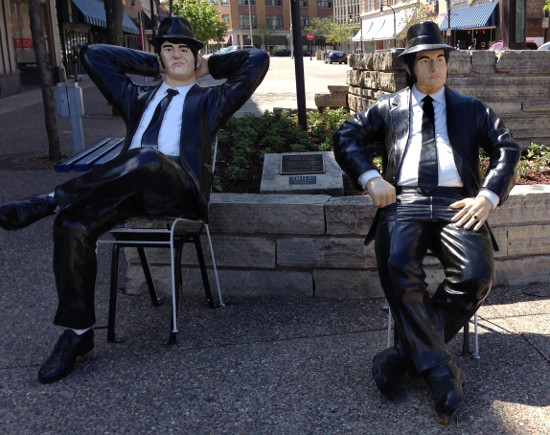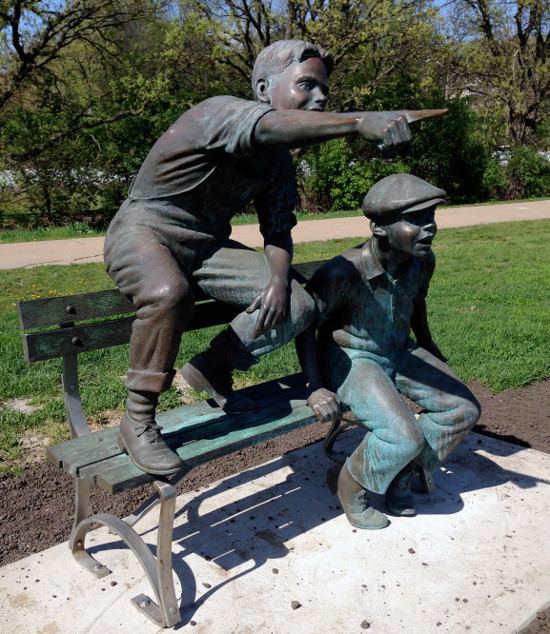
On May 2, the life-sized sculptures of the Blues Brothers were back on public display in the Rock Island District after months of storage and repairs. The sculptures are seated in chairs near the corner of Second Avenue and 18th Street.
On the same day, Watching the Ferry - a sculpture of two boys seated on a park bench - was unveiled at its new site in Davenport's Lindsay Park near the riverfront. This sculpture had been out of public view for five years, since its removal from near the Iowa American Water treatment plant when construction began on a floodwall.
Although the timing was a coincidence, the two sculptures share some similarities. Both depict two young men seated side-by-side and convey a sense of camaraderie. Both look to a past associated with the Quad Cities. Both are based on works in other media: television and film with the Blues Brothers and a lithograph with Watching the Ferry.
A comparison between the two pieces is intriguing because of this difference in their sources - as well as in their attitudes, materials, and locations.
John Belushi and Dan Aykroyd first put on the Blues Bothers' signature sunglasses, fedoras, black suits, and narrow ties on Saturday Night Live in the late 1970s. The skit blossomed into a number-one album on the Billboard charts and a sold-out concert tour and culminated with a movie in 1980.
The movie tells us that the brothers grew up in a Rock Island orphanage. The city embraced this fictional backstory with the dedication in 2006 of these sculptures - purchased in honor of Dan Carmody for his service as president of Renaissance Rock Island.
Their presence in the District reminds us of this area's blues and jazz connections - much like the Blues Brothers characters introduced new generations to some of the great R&B and soul songs of the 1950s and '60s.
While the Blues Brothers are drawn from fictional characters, Watching the Ferry is based on a 1947 lithograph by Quad Cities artist John Bloom, who worked with Grant Wood as a mural painter early in his career. Bloom was sketching at LeClaire Park when he saw two boys watching the W.J. Quinlan ferry. The lithograph and the sculpture differ in that one of the boys in the sculpture is pointing toward the river, while neither is pointing in the lithograph.

Sculptor Louis Quaintance, a Rock island native, used his 12- and 14-year-old nephews as models. The sculpture was unveiled on September 26, 1992.
In both sculptures, the figures don't directly acknowledge one another. Yet we feel their comfort sitting together, buddies not having to impress the other. This sense of companionship and each figure's ease of gesture and pose are the strengths of these artworks.
Yet they project different emotions. The boys' unbridled excitement contrasts sharply with the cool demeanor of the Blues Brothers.
The use of materials also contributes to their disparate sensibilities; we respond to the sculptures differently because of our associations with the materials.
Cast in bronze, Watching the Ferry conveys a sense of importance and permanence. This is a traditional "fine arts" medium.
On the other hand, the Blues Brothers sculptures are made of resin and fiberglass, media associated with commercial products. The sculptures are unsigned; and the artist's name is not included on the nearby plaque - reinforcing the sense that they are objects not worth our consideration as works of art.
That contrast is underscored by their locations - one on a street in an entertainment district, the other in a park.
Neither work is meant to challenge, push, or confront us. They are nostalgic and comfortable. Yet their differences in mood and era present us with distinct snapshots of our community's past. They also provide us with an opportunity to examine our perceptions of what is and is not art.
Bruce Walters is a professor of art at Western Illinois University.
This is part of an occasional series on the history of public art in the Quad Cities. If there's a piece of public art that you'd like to learn more about, e-mail the location and a brief description to BD-Walters@wiu.edu.








